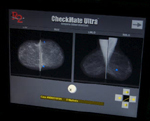Technology improves breast cancer detection
by Heather MurphyPublic Relations
The American Cancer Society estimates that of the 3,400 South Carolinians diagnosed with breast cancer this year, 600 will die. Early detection can help improve a woman’s chance of survival, but diagnosing breast cancer can be difficult. What if enhanced technology could prevent one or two of those predicted deaths? Wouldn’t it be worth getting?
The staff in MUSC Mammography thinks so. That’s why they have the R2 Computer Aided Diagnosis (CAD) ImageChecker to double-check mammo-grams.
And it’s the only one in Charleston.
 The
ImageChecker screen on the right shows an abnormality in breast tissue
by denoting the area with a colored triangle mark.
The
ImageChecker screen on the right shows an abnormality in breast tissue
by denoting the area with a colored triangle mark.
It’s the first FDA-approved computer aided detection system for use in breast cancer screening and can be used in conjunction with film based mammography.
After digitizing a film mammogram, the system’s software analyzes the image and draws attention to suspicious features that may be indicative of cancer and designates them with coded marks. The radiologist interprets the mammogram and then reads it with the CAD. If an image is marked, the radiologist consults the original mammogram to review the area in more detail.
“The bottom line is that clinical trials demonstrate a 10 percent improvement in cancer detection with CAD,” said Lisa F. Baron, M.D., Hollings Mammography Center co-director. “This translates into detecting an extra one to two cancers a year.”
According to Baron and contrary to media portrayal, breast cancer can elude mammographers. Up to 20 percent of palpable cancers can’t be seen on a mammogram.
Perhaps this is why breast cancer remains the number one cancer of women.
“While we are very proud to have this machine, it’s important to note that a mammogram, even with a computer aided detection system, can not detect all cancers. Mammograms are not the only means of breast cancer detection,” Baron said.
Mammograms are part of a three-step detection process, preceded by regular self-breast exams and clinical screening by a health care provider.
Baron stressed the importance of the physical exam. Sometimes a lump may be felt, but because its density is that of breast tissue, it may not be detected by a mammogram.
While the ImageChecker helps with this problem, a mammogram provides no guarantee, hence the reason for routine breast cancer screening.
“We will do whatever we can to encourage people to use routine mammograms as well as physical examinations as the tools to detect breast cancer. Women have to be proactive in their health care,” Baron said.
Understanding the importance of remaining on the edge of breast cancer
detection and staying true to the MUSC mission, Baron applauded the appropriations
committee for “being very supportive and cognizant that this technology
can save lives. We are truly grateful to the University for making this
technology available to our patients.”
Catalyst Online is published weekly, updated as
needed and improved from time to time by the MUSC Office of Public Relations
for the faculty, employees and students of the Medical University of South
Carolina. Catalyst Online editor, Kim Draughn, can be reached at 792-4107
or by email, catalyst@musc.edu. Editorial copy can be submitted to Catalyst
Online and to The Catalyst in print by fax, 792-6723, or by email to petersnd@musc.edu
or catalyst@musc.edu. To place an ad in The Catalyst hardcopy, call Community
Press at 849-1778.